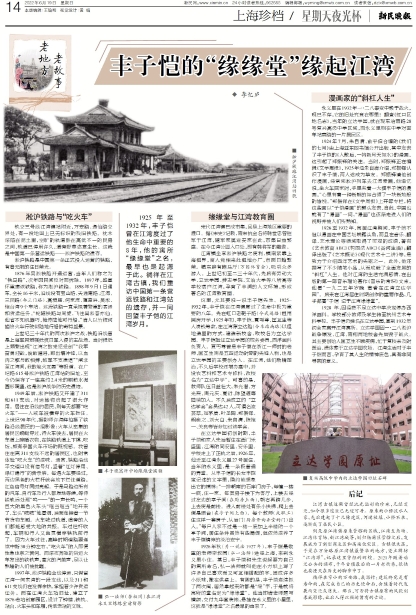Old places, old stories | The origin of Jiangwan: Feng Zikai’s fate in the pastFly into the homes of ordinary people
From 1925 to 1932, Feng Zikai spent the important 8 years of his life in Jiangwan, and the name of his residence “Yuanyuantang” originated here. Wandering in Jiangwan Ancient Town, we revisited the remains of China’s first operating railway and Jiangwan Station, and looked back at Feng Zikai’s Jiangwan years together.
Songhu Railway and “Eat the Train”
Near Jiangwan Town Station of Metro Line 3, at the junction of Wan’an Road and Yixian Road, there is a dilapidated railway that has no sign on the map. The sleepers are deeply immersed in the soil, and the empty tracks lie between the houses of different heights. This is the remains of the Songhu Railway, the first operating railway in China.
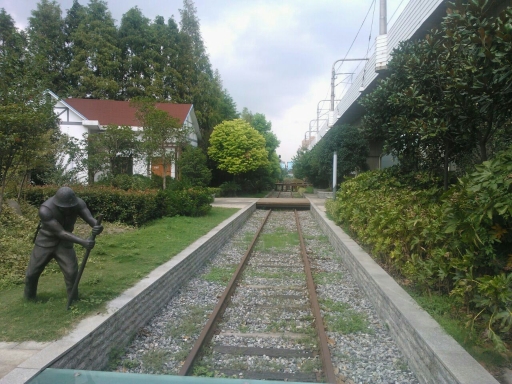
Abandoned section of the Songhu Railway
The Songhu Railway is the first railway in China to be officially put into operation, and it has infinite glory in the past.
In 1876, the Wusong Railway was put into operation. It was called the “Iron Horse Road” and was demolished the following year due to opposition from the people. In 1897, Sheng Xuanhuai rebuilt the railway and called it the Songhu Railway. It was opened to traffic on September 1, 1898, with a total length of 16 kilometers. There are Baoshan Road, Tiantong’an Road, Jiangwan, Sanmin Road (now Sanmen Road), Gaojing Temple, Hejiawan, Wezaobang, Wusong, Cannon Taiwan has 9 stations. This railway has always undertaken heavy passenger and freight tasks. “The wheel follows the railway and travels around, flying to Wusong, and the passengers are also immortals. He is not aware of the ingenuity of machinery, and it is rumored that boats can be carried on land.” The Qing Dynasty used bamboo branches to describe the peculiar scene of trains traveling like land boats.
During the two Battles of Songhu in the 1930s, along the railway line was the main battlefield for the stubborn resistance of Shanghai navy people to the Japanese invasion. At that time, newspapers frequently appeared in the newspapers that “the enemy in Jiangwan was wounded”, “our army fought bravely, and as soon as the enemy approached, we rushed out of the soil and fought the enemy with flesh and blood, and the enemy army did not retreat.” During this time, our enemy’s artillery bombarded each other” and other reports. At the former site of the Jiangwan Station of the Songhu Railway at No. 615 Guangji Road, a reinforced concrete circular bunker with a height of about 2.4 meters is still preserved, which is a historical relic of the Songhu War.
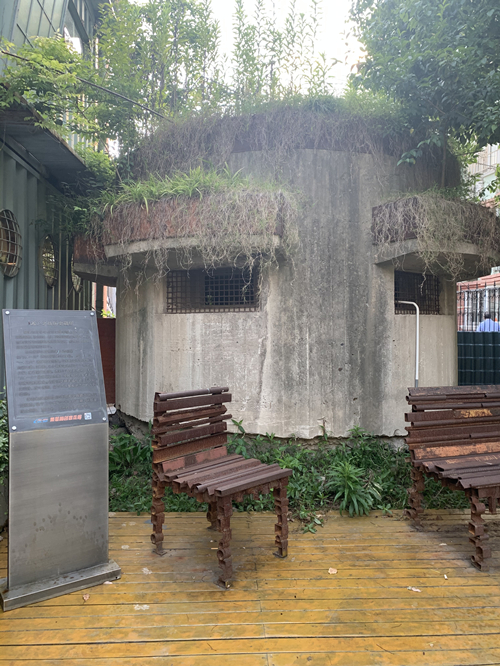
On the west side of Jiangwan Station of Songhu Railway, a bunker preserved in the 1930s
After 1949, the Songhu Railway built 311 and 611 branch lines, which played a great role in transporting materials. Residents living along the line have to “eat the train” every day – people or cars are stopped by the crossing trains. In the 1990s, photographer Xu Haifeng took a series of images of the residents along the railway line: the train winds through the dense residential area, and when the train leaves, the residents dry their clothes on the train track, play chess and eat on the railway track, It has a sense of sight of the Thai train market. I used to live in a residential area not far from the 311 branch line, and I often experienced the taste of “eating a train”. Usually, there are signal lights at the level crossings along the railway line, and the signs that “red lights are disabled, green lights pass” are erected. Whenever a train is about to pass by, the large black railings on both sides will be lowered to block the road, and the red signal lights will light up at the same time. So all the cars, bicycles and pedestrians on the side of the road waited in place, waiting for the long beep of “woo-” in the distance of the railroad tracks, and a huge black locomotive came “bang dang bang dang”, the front of the car “squeaked” Smoke was coming, and a freight car was attached to the back. As the train passes the track, people on the side of the road can feel the resonance of the earth. The cars passed the railings and folded, and the cars and pedestrians swept across the tracks again. Because the train passes by, the road will be interrupted for about 30 minutes during peak hours, and people who “eat the train” will do nothing even if they are impatient. The sound of the railroad tracks and the high-pitched whistle of the freight train running late at night is enough to wake up the sleeping people.
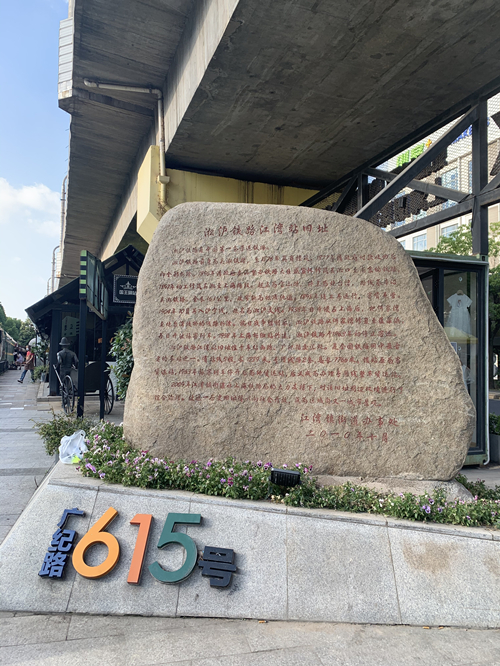
The current appearance of the former site of the Jiangwan Station of the Songhu Railway
In 1997, the entire Songhu Railway was suspended, and only a section of the Jiangwan-Hejiawan branch line, as well as the 311 and 611 branch lines, were still exerting their residual heat and undertaking a few freight tasks. On the former site of Jiangwan Railway Station, the 1876 Old Station Creative Park was established, and the clock tower, railway tracks, platforms, locomotives and carriages were designed to inherit the culture of the old station.

The old appearance of Jiangwan Station of Songhu Railway
Yuanyuantang and Jiangwan Education Circle
Jiangwan Town in Song Dynasty has become a market and an important port in Shanghai. According to “Song History” records, Han Shizhong, a famous anti-gold general in the Southern Song Dynasty, once garrisoned in Jiangwan, and the family members of the army settled here, and the market became increasingly prosperous. At the entrance of Jiangwan Park today, there is a statue of General Han.

Statue of Han Shizhong in Jiangwan Park
Jiangwan Town enjoys the convenience of the Songhu Railway, and the south of the town is close to the Shanghai Concession. Businessmen come here to lease land to set up factories, and the market is becoming more and more prosperous. There is a horse racing hall (Universal Sports Association) in the east of the town, which attracts many tourists. From the beginning of the last century to the 1920s and 1930s, eight colleges and universities including Labor University, Rieter Academy, Zhizhi College, and Wenzhi University successively settled in Jiangwan, which nurtured a rich humanistic environment and formed a famous Jiangwan education circle.
Here, I especially want to talk about Mr. Feng Zikai. From 1925 to 1932, Feng Zikai spent the most important eight years of his life in Jiangwan Town. First rented a private house on Hongkou Laodarzi Road (now Wujin Road) to start school. In early 1925, Feng Zikai, Xia Chengzun, Kuang Husheng and others pooled money to raise money and built houses on the original Lida Road (now Zhannan Road) in Jiangwan. way to build a new school building, named Rieter Academy. Feng Zikai served as the school committee member of Rieter Academy and the head of the Western Painting Department. Xia Chengzun was Feng Zikai’s teacher in Zhejiang’s first division, and Kuang Husheng was a pioneer during the May Fourth Movement and the main founder of Lida Academy. In Jiangwan, they worked hard, and soon after, the school added a high school, and set up agronomy and art specialization courses, and the school was renamed “Rieter Middle School”. The good news is that the team of teachers is growing day by day, with Zhu Guangqian, Fang Guangtao, Tao Yuanqing, Xia Yan, Chen Wangdao and others joining in one after another. The “Rieter Society” established soon has 42 members, which can be described as a collection of celebrities, such as Mao Dun, Ye Shengtao, Zheng Zhenduo, Hu Yuzhi, Liu Dabai, Zhu Ziqing, Chen Baoyi, Guan Liang, etc. have all participated in the society.

Yuanyuantang plaque in Feng Zikai’s apartment
During the start-up period of Rieter Academy, Feng Zikai and his family temporarily lived in Leshengli in Ximen, Tonganli in Jiangwan, and Anleli in succession. After the school was on the right track, in 1926, he moved to live at No. 27 Yongyili, Jiangwan. Back then, Yongyili was a very ordinary alley. From the words written by Feng Chenbao, the eldest daughter of Feng Zikai, we can vaguely imagine what it looks like: “A row of south-facing Shikumen houses, each on the first floor and at the bottom, lives in one family. The downstairs of each house is In the living room, go upstairs to pass the pavilion on the left (above the kitchen), take a few steps to the right, and go up to the front building. There is a small escalator when you enter the front building, and you can climb up to the sun terrace (above the pavilion). Each Teachers (or staff) live in such a house, and they go in and out from the back door (the door from the kitchen to the alley).” Each household is just a pavilion on the first floor and the bottom plus half of the floor. Although the living conditions are a bit cramped, they are still nourishing. The indifference and tranquility of Feng Zikai’s spirit.
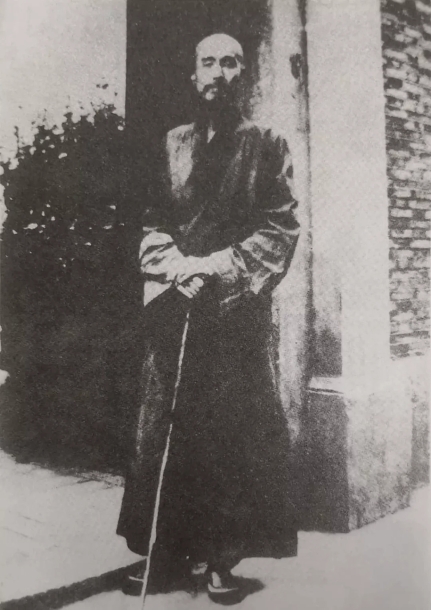
Li Shutong(Master Hongyi) took a photo in front of Yuanyuan Hall in Yongyi Lane, Jiangwan
In the autumn of 1926 (another version was 1927), Li Shutong (Master Hongyi), Feng Zikai’s most respected teacher, passed through Shanghai and came to live in Yongyili. One day, Feng Zikai told his husband that he wanted to name his apartment, so Master Hongyi asked him to write a lot of words that he liked and could match each other on a small square of paper. superior. Interestingly, Feng Zikai cast lots of lots twice in a row, but all he picked up were the word “Yuan”, so he named the house’s hall as “Yuan Yuan Tang”. He immediately asked the teacher to inscribe the banner, handed it over to Jiuhuatang for mounting, and hung it in the hut in Yongyili. This is the earliest origin of the name “Yuanyuantang”.
Cartoonist’s “Slash Life”
Yongyili was destroyed by war in the January 28th Incident in 1932, and it no longer exists. Where is its former site? Looking through the “Hongkou District Place Names”, the Lida Academy of that year was located in the area of Fuxing Senior High School at No. 28 Zhan South Road, while Yongyili was in a residential area opposite the middle school on Zhan South Road.
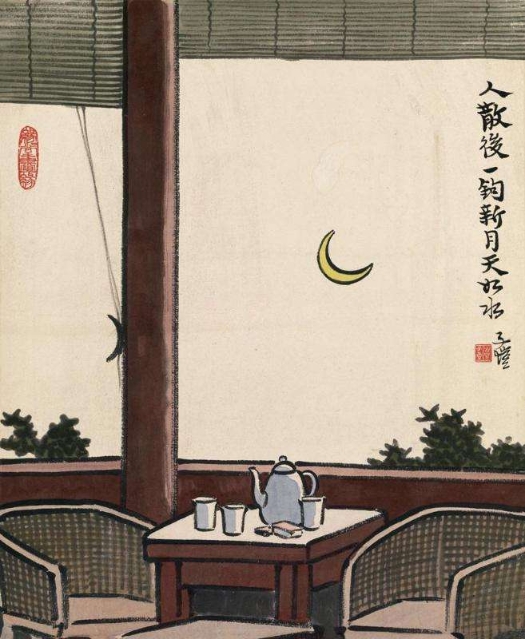
Zikai’s cartoon: After people leave, a crescent moon is like water
In July 1924, “Our July” co-edited by Zhu Ziqing and Yu Pingbo was published by Shanghai Yadong Library, in which a cartoon of Feng Zikai’s “After the people disperse, a crescent moon like water” was published, which caused Zheng Zhenduo’s attention. At that time, Zheng Zhenduo was editing the “Literary Weekly”. In 1925, through Zhu Ziqing’s introduction, Zheng Zhenduo met Feng Zikai, and the two became close friends. Zheng Zhenduo invited him to create comics, and he often took the Songhu train to Jiangwan for painting. He recalled that when he took the train home, he had a large bundle of Feng Zikai’s comics in his hand. A piece of joy like a new land.” Zheng Zhenduo opened a column in the “Literary Weekly” and published these paintings under the title “Zikai Comics”. Into people’s field of vision and to be known by people.
From 1926 to 1932, while living in Jiangwan, Feng Zikai not only made his mark in the Chinese art circle with comics, but also made considerable achievements in music, translation, art theory and other fields. He is the author of “ABC of Art Education” and “ABC of Composition”. “Gu He Life”; translated and published “Art Introduction”, “Twelve Lectures on Modern Art”, etc., is one of the pioneers dedicated to introducing Western art. In addition, he also wrote a lot of essays and sketches, thus achieving a well-rounded “slash” life. He is full of affection for Jiangwan’s life. At the end of his first music theory book “Common Sense of Music”, he signed “The late author in 1925 was in Jiangwan Rieter Academy”. Almost all of the important works created during the period of his residence in Jiangwan were marked “Zi Kai’s Records in Jiangwan Yuanyuantang”.
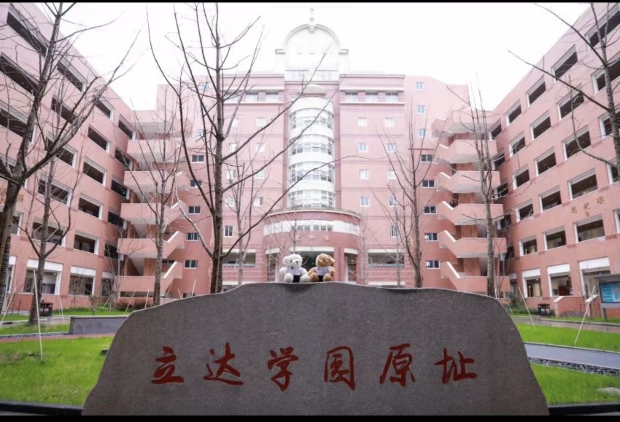
Stone monument of the former site of Lida Academy in Fuxing High School
In 1928, Rieter Middle School decided to suspend the Western Painting Department due to lack of funds. Some teachers and students of the school were transferred to Hangzhou Art College. Feng Zikai remained in Lida Academy until the family left Jiangwan Residence in early 1932. Due to the outbreak of the Songhu War on 1.28, the school buildings in Jiangwan and Nanxiang were destroyed in the war. Its main founder, Kuang Husheng, disregarded his illness, was busy resuming school and failed to get medical treatment in time, and was buried in the Rieter Academy Farm. For Feng Zikai, life in Jiangwan gave birth to the spiritual background of his life, which is of extraordinary significance.
<<<后记
Jiangwan Ancient Town, a once radiant pearl, has undergone several changes, and now many ruins are nowhere to be found. The original Xiaoqiao Liushui family has built more than a dozen buildings successively. The river is filled and the bridge is not there, and it has gradually become a residential area.
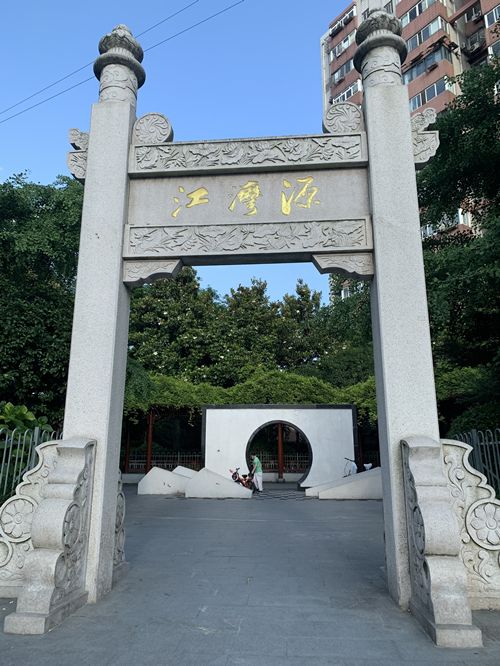
“Jiangwanyuan” archway at Wan’an Road and Xinshi South Road
On the contrary, the original jurisdiction of Jiangwan Town, Jiangwan Wujiaochang, Jiangwan Stadium, New Jiangwan City, etc., has developed into a new commercial area and high-end residential area after being placed under the jurisdiction of Yangpu District. The ancient town was very lost, so in the most prosperous part of the original Jiangwan Town on Wan’an Road, an archway “Jiangwanyuan” was erected to record the former glory here. With the promulgation of the relocation announcement in 2021, the last old streets and alleys of the thousand-year-old town will soon be annihilated in the footsteps of history.
Wandering on the narrow Wan’an Road, I thought: After all, architecture has a lifespan. After completing its historical mission, it will change or disappear with the development of the times. So, can the original features of the ancient town be recorded into images, so that future generations can trace the historical sites. (Li Yilu)
